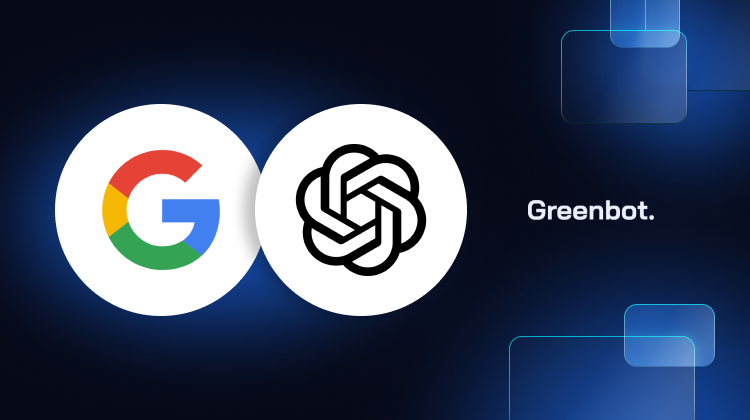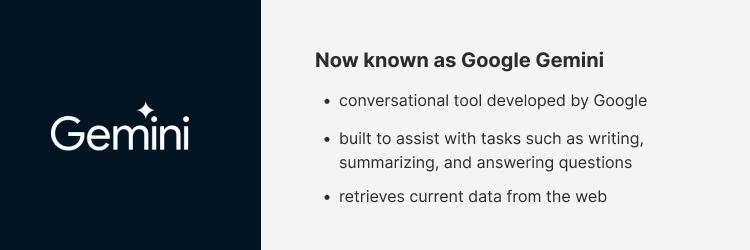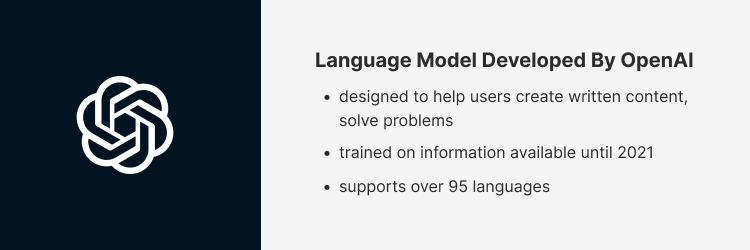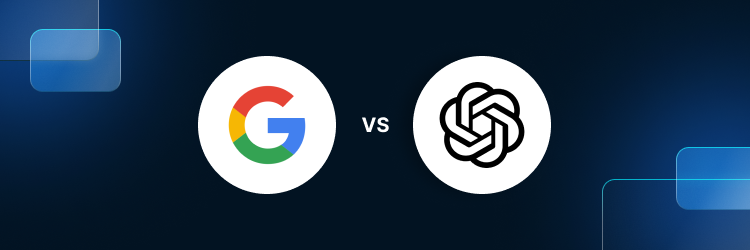
Gemini (formerly Google Bard) and OpenAI’s ChatGPT are two of the most powerful large language models available today. Both are designed to help with tasks like answering questions, writing content, and generating ideas.
While they serve similar purposes, they work in different ways. Google Bard pulls real-time data from Google Search. ChatGPT relies on knowledge available up to 2021.
As the Bard vs Chat GPT debate grows, this guide compares their strengths, limits, and best use cases—so you can pick the right tool for your needs.
What Is Bard AI?

Bard, now known as Google Gemini, is a conversational tool developed by Google. It was built to assist with tasks that involve natural language, such as writing, summarizing, and answering questions. Google Bard is unique in its ability to respond based on real-time information pulled directly from Google Search.
Unlike systems trained on frozen datasets, Bard retrieves current data from the web. It uses Google’s proprietary Infiniset dataset, which includes a curated mix of public content and selected sources. This setup helps Bard deliver relevant, timely, and accurate responses across various topics.
Key Features of Bard:
- Developed by Google for language-based tasks. It helps users easily write, explain ideas, and complete everyday writing.
- Real-time information access through Google Search. Bard pulls current content from the web. It’s ideal for answering questions based on live or time-sensitive information.
- Trained on the proprietary Infiniset dataset. This dataset includes public sources and select data curated by Google. It gives Bard a balanced and focused understanding.
- Focused on relevant and timely output. With live search access and curated training, Bard delivers quick and accurate responses based on the latest data.
What Is ChatGPT?

ChatGPT is a language model developed by OpenAI. It was designed to help users create written content, solve problems, and respond to text-based queries. The model is built on OpenAI’s GPT architecture, which powers its ability to understand context and generate natural-sounding responses.
ChatGPT is trained on information available until 2021. It doesn’t pull real-time information but covers a broad range of general knowledge. ChatGPT supports over 95 languages, while Bard supports around 40 languages. It performs well across various tasks, including creative writing, article generation, and writing or debugging code.
Key Features of ChatGPT:
- Developed by OpenAI using GPT architecture. Built to understand context, respond clearly, and follow various text prompts.
- Trained on public data with a 2021 cut-off. ChatGPT doesn’t use live data but offers knowledge across various topics.
- Supports over 95 languages. Offers broader multilingual support compared to Bard, which supports around 40 languages.
- Performs well in creative and technical tasks. Known for generating long-form content like blogs, stories, and detailed guides.
- Effective for coding and technical instructions. ChatGPT can write or explain code snippets across different programming languages.
Key Differences Between Bard and ChatGPT
Bard and ChatGPT serve similar functions. However, they differ significantly in how they are built, the data they use, how they integrate with other tools, and the user experience they offer. Understanding these core differences can help you choose the right platform for your needs.
Data Sources
Both tools are trained on large datasets from the internet, including articles, websites, and various text forms. Still, Bard leverages Google’s proprietary Infiniset dataset, which includes curated sources and enables access to real-time search results.
ChatGPT’s training data is publicly available and has a cutoff in 2021. This means it doesn’t reflect recent developments or updates.
Real-Time Access
Bard can access up-to-date information through Google Search. This allows it to respond with the latest available content, giving it an edge when dealing with time-sensitive topics. In contrast, ChatGPT is limited to the data it was trained on, which ended in 2021. It cannot pull in new or breaking information.
Response Style
Bard can generate multiple drafts for a single prompt, giving users different options to choose from or edit. This can be helpful when exploring ideas or refining language. ChatGPT typically delivers one response per prompt, which may require rephrasing the input to get varied results.
Integration
Bard integrates with Google’s ecosystem, making sending content directly to services like Google Docs or Gmail easy. This is useful for everyday tasks. ChatGPT supports third-party plugins, which expand its capabilities across platforms like browsers, coding tools, and productivity apps.
Google Prompting Essentials
Bard uses Google’s search engine as part of its core design. This connection enhances its prompting capabilities by pulling current data and web content into responses. ChatGPT doesn’t have this ability, as it relies on static training data and lacks real-time web access.
User Experience
Due to its diverse training, ChatGPT has been noted to be particularly strong in generating long-form text, like articles and narratives. It produces long-form and creative text better than Bard, which excels in concise factual answering. Users who need blogs, stories, or detailed content may find ChatGPT more suitable.
Bard, in contrast, performs well in quick-answer scenarios and provides multiple output drafts to improve flexibility.
Prompt Engineering
Bard offers more customization for prompts. You can adjust things like response length and tone before generating output, giving users greater control. ChatGPT uses a more straightforward prompt-response system, which works well for general use but has fewer options for tweaking responses beforehand.
Google Bard vs ChatGPT: Real-Time Information Capabilities

Bard connects to Google Search to deliver real-time responses. It can pull the latest information from the web, making it useful for recent events or trending topics. Bard’s output can include links to sources, allowing users to verify its information.
This real-time access gives Bard an edge when accuracy depends on current data. Users looking for up-to-date facts, news, or ongoing developments can rely on Bard for timely results. Its live search connection helps it stay aligned with fast-changing topics.
ChatGPT’s training data only goes up to 2021, limiting its ability to provide accurate information on events occurring after that date. As noted by Coursera, Bard is more suitable for tasks that involve live updates. In contrast, ChatGPT performs well when working with static, well-established knowledge.
Which Is Better for Business: Google Gemini or ChatGPT?
ChatGPT vs. Bard becomes more interesting when viewed through a business lens. Each tool brings different strengths depending on the task. For fast-changing topics, Bard stands out. It can pull live information from Google Search, making it ideal for industries where timing matters—like news, finance, or marketing.
Bard’s output can include links to sources, allowing users to verify its information.
On the other hand, ChatGPT excels in creative writing, content creation, and detailed explanations. It performs well when drafting blog posts, product descriptions, or email sequences. Its structure and tone are instrumental in marketing and branding projects that require depth and clarity.
Both tools can assist technical teams with coding. ChatGPT is more specialized in generating accurate code snippets for programming tasks. It’s a strong fit for teams that need help with automation, script generation, or essential development support.
Pros and Cons of Google Gemini vs ChatGPT
Bard (Google Gemini)
Pros:
- Provides real-time data through Google Search
- Easily integrates with Google Docs and Gmail
- Gives three drafts per response for more flexibility
- Includes a built-in text-to-speech feature
- Can manage reminders and basic user tasks
- Generates personalized replies in conversation
Cons:
- Has a smaller training dataset than ChatGPT
- Not ideal for generating detailed long-form content
- Doesn’t support plug-ins or third-party extensions
ChatGPT
Pros:
- Strong at creative writing, storytelling, and brand content
- Offers structured and detailed responses
- Supports plugins for added functionality (ChatGPT Plus)
- Summarizes long text effectively
- Useful for daily tasks like emails, planning, and brainstorming
Cons:
- No real-time access to current data
- Only provides one response per prompt
- Does not include a native text-to-speech option
Language Models: A Deeper Dive into Bard and ChatGPT

Google developed Bard and utilized the PaLM (Pathways Language Model) for its functionality. PaLM was built using advanced machine learning techniques to handle complex language tasks, focusing on speed, accuracy, and real-time response. It powers Bard’s ability to deliver many drafts and adjust tone or style based on the prompt.
ChatGPT is built on OpenAI’s Generative Pre-trained Transformer (GPT) architecture. It was trained using a wide range of publicly available internet data. This helps ChatGPT produce detailed answers and long-form content with firm structure and flow.
The models shape how each tool performs. Bard is better suited for short-form and interactive replies. ChatGPT, in contrast, handles structured and in-depth writing more consistently. Bard gives three drafts simultaneously, while ChatGPT regenerates one new response at a time.
Courses on platforms like Coursera teach how to apply these models in real-world settings. They focus on practical use across different industries. Tools like Bard and ChatGPT help with writing, brainstorming, and project planning in marketing, education, and software development.
Which Tool Is Better for Content Creation: Bard vs ChatGPT?
ChatGPT excels as an AI writer at content-creation tasks that require structure, clarity, and depth. It also performs well in blog writing, storytelling, and marketing content. Users often rely on it to draft long-form articles, social media copy, or scripts that need a creative touch.
Bard works best for quick, factual replies or basic writing needs. It can help with short summaries or email outlines, but struggles to match the depth and detail ChatGPT offers in longer formats. Bard’s built-in text-to-speech feature adds value for those who prefer to listen instead of read.
ChatGPT is particularly effective at summarizing long texts. This makes it useful for research-heavy content, turning complex ideas into simple, readable copy. ChatGPT Plus users can access plugins that add creative tools across different content formats.
These tools are used daily by professionals in marketing, education, and software development. They help with drafting emails, brainstorming ideas, and organizing project materials. ChatGPT is a more complete tool for users who prioritize long-form clarity. Bard is a solid option for those who want speed and simplicity.
Pricing: Bard vs ChatGPT
Below is a comparison of the pricing models and features offered by Bard (Gemini Advanced) and ChatGPT across different plans.
| Bard (Google Gemini Advanced) | ChatGPT Free | ChatGPT Plus |
| Free for 1st month (then ~$20/month) | $0/month | $20/month |
| Access to Google’s most advanced Gemini model | Access to GPT-4o (mini) | Full access to GPT-4o |
| 1 million token context window | Limited context window | Extended context window |
| Real-time search via Google | Real-time web browsing | Real-time web browsing |
| Integrates with Gmail, Docs, NotebookLM, Google Drive (2 TB) | No app integrations | No app integrations |
| No plugin support | No plugin support | Plugin support available |
| No custom AI creation | Can create and use custom GPTs | Can create and use custom GPTs |
| Voice tools not specified | Standard voice mode | Advanced voice and vision tools |
| Offers three draft responses at once | Generates one response at a time | Supports deep reasoning and research |
| No third-party app integrations | No advanced tools | No admin or team collaboration tools |
FAQs About Bard and ChatGPT
Is Bard better than GPT-4?
Bard (Gemini Advanced) works well for real-time information and short replies. GPT-4, used in ChatGPT Plus, is stronger for long-form content, structured writing, and creative tasks. The best option depends on your need—real-time data access or deep content generation.
Which AI is better than ChatGPT?
It depends on the task. Some AI tools, like Gemini (Bard), handle real-time data better. However, ChatGPT excels in summarizing, creative writing, and using plugins for extended features like data analysis and automation.
Is Google’s Bard free?
Yes, Bard has a free version, but its most advanced features come with the Google One AI Premium plan. This paid version gives access to Gemini Advanced, real-time browsing, and integration with tools like Google Sheets.
Which tool has the best real-time access to information?
Live Google Search powers Bard’s answers. It can pull details from the latest web pages, making it ideal for up-to-date content. ChatGPT’s free and Plus versions rely on pre-trained data, though Pro users can access newer tools.
Which is more accurate, Bard or ChatGPT?
Both tools are powerful, but accuracy depends on context. ChatGPT is more consistent in long-form responses and structured tasks. Bard performs better when you need fast facts and quick summaries. However, both ChatGPT and Bard may occasionally return incorrect responses.
How do Bard and ChatGPT compare in image generation?
ChatGPT Plus includes DALL-E for generating images based on prompts. Bard offers image capabilities through Google services, but is more limited. ChatGPT’s options are more flexible for creative use.
Bonus: Can these tools help with everyday tasks?
Yes. Users can leverage both ChatGPT and Bard to write emails, plan content, and summarize large blocks of text. Bard can also create reminders and manage basic tasks. These tools boost productivity across marketing, education, and software development.
Bard vs. Chat GPT: Our Final Thoughts
When comparing Bard vs. ChatGPT, both tools have different strengths. Bard is best for quick responses, real-time answers, and users who rely on Google’s ecosystem. Google Bard’s answers often reflect the latest search results, which is helpful for frequently changing topics.
ChatGPT excels in content creation, storytelling, and structured writing. It also supports features like plugins and chat history, which make it better suited for ongoing projects and collaborative work.
Both Bard and ChatGPT can improve productivity. Users can apply these tools for brainstorming, summarizing long texts, writing emails, or handling basic planning tasks. Generative AI tools are already impacting marketing, education, and software development.
For business use and creative writing, ChatGPT offers more control and versatility. Bard better fits fast facts, web-connected queries, or Google Docs integration.




















